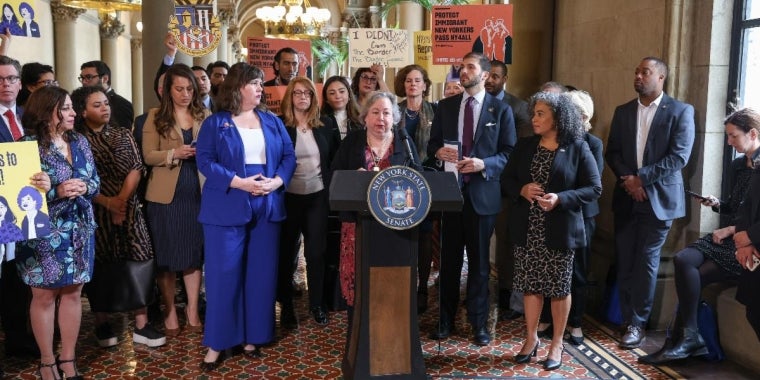
Testimony Before the New York City Council Regarding the Draft Environmental Impact Statement for the Comprehensive Solid Waste Management Plan on February 1st, 2005
Liz Krueger
July 12, 2010
Good Morning. My name is Liz Krueger, and I am the State Senator for New York’s twenty-sixth senatorial district, one primarily comprising parts of Manhattan’s Midtown and East Side. I would like to thank the City Council for hosting this public hearing.
I have chosen to testify today for a plethora of reasons. First, I oppose operating a marine transfer station (“MTS”) in any of New York City’s residential neighborhoods, especially those that are densely populated. Second, I am concerned about a battery of problems that will arise in my community if the MTS at 91st Street is designed and operated as proposed. And third, I am frustrated and insulted by the inadequate and misleading manner in which the Department of Sanitation (“DSNY” or “The Department”) has attempted to notify the public about its proposed twenty-year Comprehensive Solid Waste Management Plan (“SWMP”).
Before addressing the specific failings of the SWMP as disclosed in the Draft Environmental Impact Statement (“DEIS”), I would like to make clear that I support incorporating marine transfer stations into the City’s waste disposal solutions, and I believe that we all must be responsible for our own garbage. Manhattan garbage should be processed in Manhattan. However, when placed in or immediately adjacent to primarily residential zones, transfer stations are, in effect, non-conforming facilities that unfairly burden the host community, and placing an MTS at the proposed 91st Street site seems irresponsible and myopic.
I was alarmed when initially notified of the Department’s plan that called for a restoration of operation at the 91st Street marine transfer station. I, along with most other elected officials from this district, testified at DSNY hearings in June and December of 2004 to express this dismay. The later-released Draft Environmental Impact Statement does not reflect serious consideration of my concerns or those of many community leaders and residents because many of the reasonable questions that were originally posed remain inadequately addressed or ignored.
There must be a better site for such a facility. This location is in a densely populated residential neighborhood with limited street access for the sanitation trucks. These trucks would actually drive through the middle of children’s playing fields, parts of Asphalt Green, a unique City resource located adjacent to the MTS site. These conditions make 91st Street an inappropriate location.
Furthermore, the DEIS sets inadequate parameters for a final environmental impact statement that, as of now, will neglect both the full capacity of the MTS site and, subsequently, a comprehensive examination of the MTS impact and required mitigation. To be blunt, an MTS located at 91st Street will have deleterious effects on area traffic, odor, noise, air quality, public health, the character of the neighborhood, and the vitality of Asphalt Green.
The DEIS severely neglects the maximum operational capacity of the “converted” MTS at 91st Street, forecasting that it will receive only 1,700 tons per day (“tpd”) of waste despite possessing the capacity to actually accommodate 4,290 tpd. I imagine that the City, currently grappling with a financial shortfall, would not waste its money by erecting a facility that it intended to underutilize. Given this assumption that no one is purposely planning on wasting money, it seems reasonable to assume that a converted MTS at 91st Street would accept far more waste than the seemingly disingenuous forecast.
An MTS receiving 4,290 tons of trash from four community boards would operate six days a week and receive trucks throughout the day and night. On peak collection days, the MTS would receive 469 delivery vehicles, not the 130 projected. On off-peak days, the site would still need to accommodate—given a conservative assumption of 15-percent less traffic—398 trucks, or seventeen per hour. All trucks would drive straight through Asphalt Green. In order to go through the site, unload its contents into non-spill containers, turn around, and then exit, each truck would require more than the three-and-one-half-minutes average that the current plan would allow. Reconfiguring a few intersections or altering some traffic light patterns seem like hopeless remedies for this potential plague.
As trucks took longer to unload their cargo, those that arrived later would begin to line-up along the delivery routes—the narrow streets running east-west and congested York Avenue, a thoroughfare that already barely accommodates two bus routes, FDR Drive access, and a high volume of cars. While idling, waiting to unload the waste that they carried, the trucks would be sitting with their motors running; releasing carbon-, nitrogen-, and sulfur-based pollutants; emitting pungent odors; and creating a din. There is no adequate mitigation for the situation envisioned. And if you think that driving on York Avenue is already frustrating, wait until there are standing trucks constantly clogging the road; if you currently enjoy a restful evening of sleep, remember it fondly as truck engines roar throughout the night.
Beyond the environmental and quality-of-life problems that the MTS would cause at this location, there would also exist a significant threat to public health. With dozens of schools sending thousands of children to Asphalt Green for recreational activities, permitting heavy polluters like diesel-fuel trucks to constantly idle near the site and imperil a population particularly susceptible to respiratory ailments is not only unsafe but negligent. City-owned trucks now use ultra-low-sulfur diesel fuel; however the merchant carriers who cart so much waste are not required to follow these environmental and public health-friendly guidelines, so air pollution would certainly remain dangerous.
Unfortunately, the DEIS neglects all sorts of realistic scenarios like that which I just described. Really, the DEIS is completely unrealistic, inadequate, and arguably illegal. Among the DEIS’s primary failings, it does not provide even a basic description of how each MTS will be designed and operated; it does not adequately explain its site-selection criteria; it does not disclose other potential sites that were examined (because there were none) or properly examine four alternative plans; it does not account for a reasonable worst-case scenario given its own figures; it does not maintain internal validity with regard to site-specific impacts like odor and noise; it does not contain any sort of cost-benefit analysis weighing multiple options for long-term disposal solutions; it does not accurately forecast the problems and requisite mitigation measures with regard to noise, odor, air quality, and traffic.
As a result of this litany of errors and procedural contraventions, the DEIS that the Department has tried to push through—without significant attention paid to its problems—appears to violate multiple sections of the State Environmental Quality Review Act (“SEQRA”), notably 6 NYCRR §§ 617.2(n), 617.8(a), 617.8(f)(2), 617.8(f)(3), 617.8(f)(5), 617.9(b)(1), 617.9(b)(2), and 617.9(b)(5)(iii). Were the DEIS not plagued by so many substantive problems, the mere presence of so many seemingly demonstrable legal transgressions would argue against approval of the proposed SWMP because the City and State of New York would be inviting a protracted and expensive lawsuit. Taxpayers should not be asked to foot the bill for the preventable errors of their government.
Even worse than the problems contained in or demonstrated by the DEIS has been the DSNY response when members of the public have voiced their concern and opposition, a statutory component in this entire approval procedure. As these errors of omission or purposeful neglect have emerged and been cited, the Department of Sanitation has hastily scrambled to pacify the discontented with baseless new numbers outside of the DEIS (and, subsequently, the City Environmental Quality Review process) or has just dismissed complaints and objections.
At a Community Board 8 Land Use Committee meeting held on January 12th, 2005, Sanitation Commissioner John Doherty presented a revised MTS plan for 91stStreet that included new, never-before-seen figures. Whereas the DEIS calls for 1,700 tons of waste to be delivered to the MTS each day and acknowledges that the site could accommodate as much as 4,290 tpd, Commissioner Doherty instead contradicted his own department’s DEIS and assured the audience that the 91st Street MTS would receive no more than 1,500 tpd of waste. He also dismissed the idea that an adequate DEIS would have also accounted for a worst-case, 4,290-tpd scenario by saying that it was highly unlikely that the site would ever process that much waste in a day. In fact, he said that only in the event of some sort of waste apocalypse would the 91st Street MTS need to accept so much refuse. If that be so, why would the City waste money by building a facility that exceeded the necessary capacity almost three times over?
At that same forum, Commissioner Doherty responded to inquiries about how the 91st Street site was selected with the scientific, “Quite frankly, we haven’t looked at much else....” This answer was particularly disappointing because it was emblematic of the brazen attitude that DSNY has taken regarding the SWMP approval process. In fact—and as presented by the DSNY-hired architectural consultant—the proposed MTS will not be a “reconfigured” or “converted” site, as it has been conveniently termed, but rather, it will be an entirely new building. What remains of the old facility will be destroyed, reduced to a lone pier jutting out into the East River, and a wholly new building will be erected just north of the old site. This new facility will be built on top of to-be-erected decking that will have a western-most boundary over the East River, beyond the eastern-most point of the Manhattan island property line. This sort of schematic does not depend upon the pre-existing built environment in any way, so why couldn’t this facility have been built anywhere else? If it can be erected on arbitrarily placed outboard decking, why place an MTS in the midst of a dense residential neighborhood and on top of a unique resource like Asphalt Green?
The questions I have posed today are simply a few among many others that remain unaddressed by DSNY, and I hope that the City Council will hold the Department accountable for such dereliction of their responsibilities and legal mandates.
I’d also like to conclude by adding that if the City is serious about its need to reduce waste and find better ways to accommodate it, there are a number of alternatives that should be included in the Solid Waste Management Plan (SWMP). It could start by supporting state-level efforts, like my “bottle bill,” to expand recycling programs, increase bottle deposits, and cover more types of beverage containers. This would create a dedicated revenue stream that could preserve and promote City recycling, insulating it from the often-senseless budgeting process. New York could also decrease its waste stream by cutting back the distribution of unwanted direct mail and catalogues. Managing bulk waste would also behoove the City, and implementing a system to redistribute items like computers, bicycles, and furniture could potentially result in a 15-percent reduction of the waste stream. City agencies could also adopt a waste-prevention incentive program because these arms of government get free collection services.
There are a number of alternatives to be explored, and while the specifics of the strategy may be cause for disagreement, a consensus has emerged that the SWMP and its DEIS are inadequate, disingenuous, and likely illegal. Thank you very much for your attention to these concerns.

